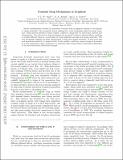Coulomb Drag Mechanisms in Graphene
Author(s)
Abanin, Dmitry A.; Song, Justin C. W.; Levitov, Leonid
DownloadLevitov_Coulomb drag.pdf (5.608Mb)
PUBLISHER_POLICY
Publisher Policy
Article is made available in accordance with the publisher's policy and may be subject to US copyright law. Please refer to the publisher's site for terms of use.
Terms of use
Metadata
Show full item recordAbstract
Recent measurements revealed an anomalous Coulomb drag in graphene, hinting at new physics at charge neutrality. The anomalous drag is explained by a new mechanism based on energy transport, which involves interlayer energy transfer, coupled to charge flow via lateral heat currents and thermopower. The old and new drag mechanisms are governed by distinct physical effects, resulting in starkly different behavior, in particular for drag magnitude and sign near charge neutrality. The new mechanism explains the giant enhancement of drag near charge neutrality, as well as its sign and anomalous sensitivity to the magnetic field. Under realistic conditions, energy transport dominates in a wide temperature range, giving rise to a universal value of drag which is essentially independent of the electron–electron interaction strength.
Date issued
2013-07Department
Massachusetts Institute of Technology. Department of PhysicsJournal
Nano Letters
Publisher
American Chemical Society (ACS)
Citation
Song, J. C. W., D. A. Abanin, and L. S. Levitov. “Coulomb Drag Mechanisms in Graphene.” Nano Lett. 13, no. 8 (August 14, 2013): 3631–3637.
Version: Original manuscript
ISSN
1530-6984
1530-6992